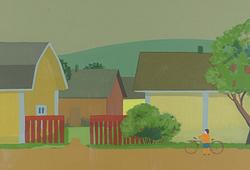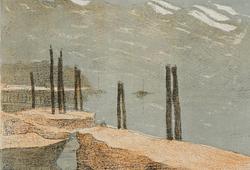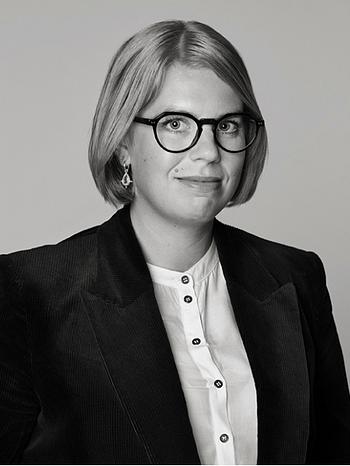Anna-Eva Bergman
"N°5-1959"
Signed AEB and dated 1959. Tempera and metal foil on paper, 27 x 37.5 cm. The work is included in the Catalogue raisonné of Anna-Eva Bergman.
Alkuperä - Provenienssi
Gallery Kaare Berntsen, Oslo.
Purchased from the above around 2005/2006.
Muut tiedot
Created in 1959, "N°5-1959" belongs to the moment when Anna-Eva Bergman found the language that would define her art: luminous, essential forms charged with both monumentality and restraint. Against a textured blue ground, a single, keel-like figure emerges — part vessel, part mountain, part timeless sign. Its clarity is striking, its surface alive with the metallic glow that became her signature medium.
Bergman, born in Stockholm and raised in Norway, lived and worked between Scandinavia, Spain, and France. In 1957 she remarried Hans Hartung, and together they settled in Paris. Their home and studio on Rue Gauguet gave Bergman the freedom to explore larger formats — a liberation she herself described as a decisive step towards “the grand style.” This work, with its bold simplicity and radiant surface, anticipates the monumental canvases of the 1960s, including the celebrated Pyramide and Tombeau de Théodoric series.
By the late 1950s, Bergman was already recognized by leading French critics such as Pierre Gindertael, Michel Ragon, and Herta Wescher. They praised her ability to distill a sense of density and unity, to conjure celestial and terrestrial forms that carried both consolation and power in an age of conformity. Her 1958 exhibition at Galerie de France confirmed her as an artist of rare promise — and it was in the immediate wake of this success that Komposisjon was created.
Today, Bergman is celebrated as one of the most distinctive European abstractionists of the post-war era. Major retrospectives — Voyage vers l’intérieur at Musée d’Art Moderne de Paris (2023) and Becoming Anna-Eva Bergman at the National Museum in Oslo (2024) — have secured her place within the canon of modern art. The Centre Pompidou has recently acquired important works, and her international market has been amplified by representation with Galerie Perrotin.
"N°5-1959" is therefore more than a rare early foil painting: it is a crystalline statement of Bergman’s vision at the very threshold of maturity. Its strength lies in its simplicity — a single form, luminous and absolute — embodying both her Nordic sensibility and the Parisian avant-garde. A museum-quality work, it stands as a beacon within her oeuvre, capturing the moment she stepped into her “grand style.”










































